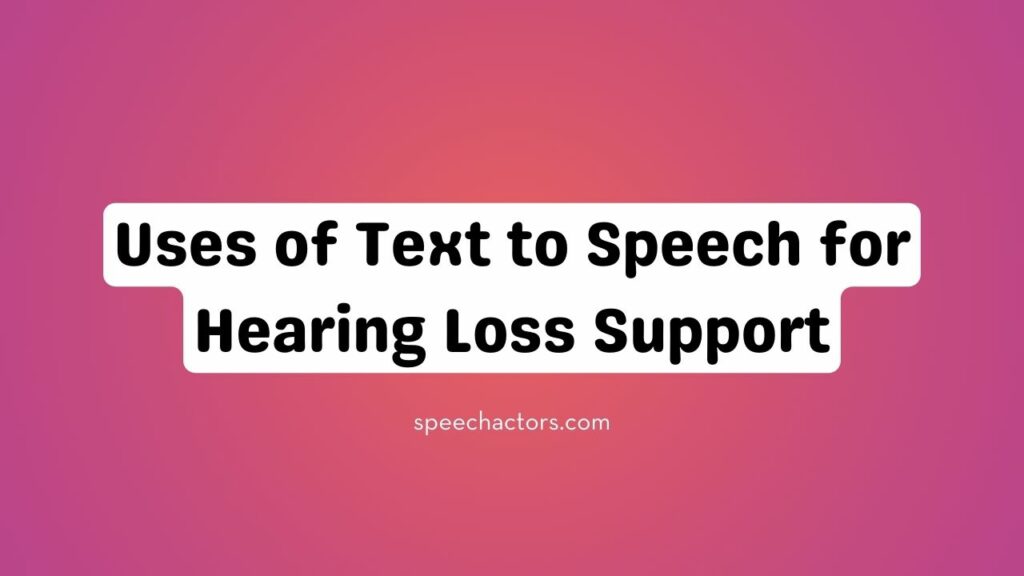Hearing loss affects millions worldwide, creating challenges in communication, learning, and accessing information. Text-to-Speech (TTS) technology transforms written text into natural, clear audio, making content more accessible and engaging.
This innovative tool empowers individuals with hearing difficulties by providing an alternative way to experience information, participate in conversations, and enhance learning.
In this blog, we explore the practical uses of TTS for hearing loss support, highlighting how it bridges communication gaps, fosters independence, and improves everyday interactions, making information accessible to everyone with ease and clarity.
Understanding Hearing Loss
Hearing loss occurs when someone has difficulty hearing sounds clearly. It can be mild, where soft sounds are hard to hear, moderate, making normal conversations challenging, severe, needing louder sounds or hearing devices, and profound, where hearing is extremely limited.
Hearing loss affects daily life, making it harder to enjoy conversations, music, or social gatherings. In education, students may need extra support to follow lessons, participate in discussions, or understand instructions.
At the workplace, communication with colleagues, meetings, and phone calls can require additional effort. People with hearing loss often face barriers like misunderstandings, missed information, or social isolation, impacting how they connect and engage with others.
How Text-to-Speech Works for Hearing Loss Support
Text-to-Speech (TTS) is a technology that changes written text into spoken words. It reads any text aloud using natural-sounding voices, helping people with hearing difficulties follow information more easily.
TTS works by analyzing the text, understanding the words and punctuation, and then generating clear speech that matches the tone and rhythm of human conversation. Many devices and platforms use TTS to make content accessible, including smartphones, tablets, computers, and smart assistants like Google Assistant, Amazon Alexa, and Apple’s VoiceOver.
TTS also powers reading apps and educational tools, making books, articles, and messages easier to listen to and understand.
Key Uses of TTS for Hearing Loss Support
Assisting in real-time communication: TTS converts typed messages into spoken words, enabling people with hearing loss to participate in conversations through chat-to-speech tools, live events, or meetings.
Supporting education: TTS helps students with hearing impairments by improving reading comprehension, providing accessible study materials, and supporting classroom engagement with clear audio outputs.
Facilitating workplace communication: TTS streamlines collaboration by transforming written content like emails, reports, or chat messages into voice, making professional communication more inclusive and productive.
Enhancing accessibility for online content and e-learning platforms: TTS ensures equal access to digital resources by reading aloud web pages, course modules, and training materials, promoting inclusive learning and engagement.
Benefits of Using TTS for Individuals with Hearing Loss
- Improving independence in communication
- Reducing cognitive load in understanding written text
- Enhancing engagement in learning and social interactions
- Providing multilingual support for broader accessibility
Choosing the Right TTS Solution for Hearing Loss Support

Voice clarity, natural tone, and customization options play a key role in supporting people with hearing loss. A clear and realistic voice helps users understand content easily and feel more connected while listening.
Features like adjustable speed, multiple language options, and broad device compatibility make TTS tools versatile for different needs. Speechactors stands out as a leading solution, offering lifelike voices and smooth pronunciation that enhance accessibility.
Its ability to adapt tone, pace, and character voices ensures an engaging listening experience. Using a reliable TTS platform transforms reading into effortless listening, making information more accessible and enjoyable for everyone.
Real-Life Applications and Case Studies
Real-life applications of text-to-speech technology are transforming education, workplaces, and online learning platforms. In schools and universities, students use TTS to read textbooks aloud, helping them focus and understand difficult subjects.
Workplaces use TTS for training modules and presentations, making content accessible to employees with different learning styles. Online platforms like e-learning websites integrate TTS to provide audio versions of courses, improving engagement and retention.
Users with hearing loss share that TTS allows them to follow along with written content more comfortably and stay connected with learning and work materials. These examples show how technology creates an inclusive, interactive, and productive environment for everyone.
Frequently Asked Questions (FAQs)
Can TTS help with all types of hearing loss?
Text-to-speech (TTS) helps people with mild to severe hearing difficulties by converting written text into clear spoken words, making communication and learning easier.
How accurate and natural is the TTS output?
Modern TTS voices are highly accurate and sound natural, with advanced AI capturing intonation, rhythm, and pauses, creating a realistic and human-like listening experience.
Is TTS suitable for children and elderly individuals?
TTS works well for both children and elderly users, supporting reading, learning, and daily communication with simple, easy-to-understand, and clear speech output.
Can TTS integrate with other assistive technologies?
TTS can seamlessly work with hearing aids, screen readers, and captioning tools, improving accessibility and enhancing overall communication and learning experiences.
How to get started with Speechactors for hearing loss support?
Speechactors offers easy access to TTS voices online. Users can choose voices, adjust speed and tone, and start listening immediately for hearing support and learning needs.
Conclusion
Text-to-speech (TTS) technology offers a powerful solution for supporting individuals with hearing loss, enhancing accessibility, communication, and learning experiences. By converting written content into clear, natural-sounding audio, TTS bridges communication gaps in classrooms, workplaces, and daily life.
Platforms like Speechactors provide versatile tools to integrate TTS seamlessly, empowering educators, employers, and individuals to create inclusive environments. Embracing TTS not only improves engagement but also fosters independence and confidence for those with hearing challenges. Explore TTS today and make accessibility a standard, not an option.
